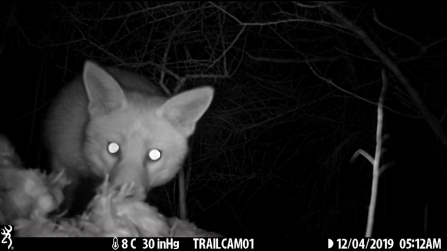
Fox caught on trail camera. Image by: Catch My Drift.

Fox caught on trail camera. Image by: Catch My Drift.
The cameras have also helped the team identify the presence of the invasive signal crayfish, which was introduced from North America. It out competes our native white-clawed crayfish and spreads crayfish plague, a fungus-like disease.
The Project, funded by players of the National Lottery via a grant from The National Lottery Heritage Fund, is working to improve the land and habitat for people and wildlife on its 185-hectare East Chevington nature reserve. It is titled ‘Catch my Drift’ as a nod to the reserve’s history as it was once the East Chevington Drift Mine (1882 - 1962) and East Chevington Opencast Coal Site from 1982 - 1994.
The footage collected will allow Catch My Drift project leader Sophie Webster to gain an understanding of how these animals are using the site, which will, in turn, help her develop an overall management plan for the site.
As well as using the standard method of attaching cameras close to animal tracks, the team, led by Sophie, has been installing small mammal camera boxes which have allowed them to monitor their presence during winter when they cannot carry out live humane survey trapping to help them identify key areas where birds of prey may feed and which species they may be feeding on.
Even more exciting, the team has just installed a ‘mostela’: a box with a pipe and a camera developed by the Small Mustelid Foundation, to record the presence of Stoats and Weasels. It relies on the curiosity of the animals to investigate the box. The data collected from the mostela will feed into E.R.I.C the local biodiversity record centre and the larger database of The Mammal Society, to gain an understanding of the status of small mustelids in Britain.
Sophie Webster says: “It has been great fun for myself and my volunteers exploring the many ways of using camera traps. East Chevington is a large site with many different habitats and it’s impossible to be everywhere at once, but the cameras let us have that presence. It can be a long process going through all the footage but it’s very rewarding when we get to observe behaviours of our species that we may not have been able to see in person and when we can record new species for the site.”